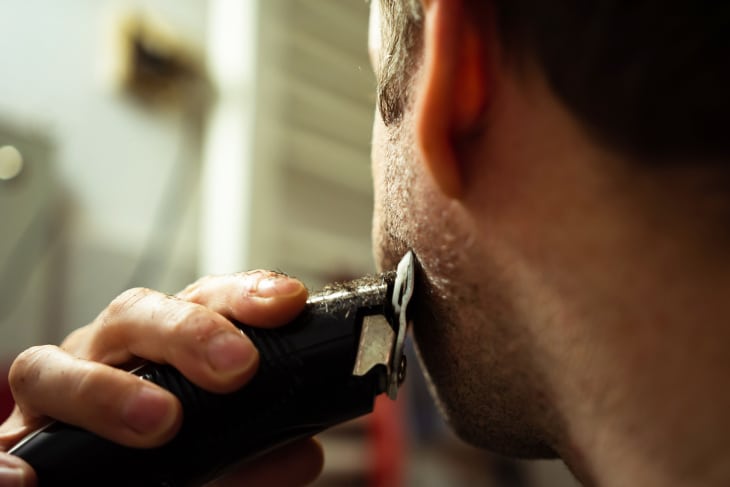We’ll get to our electric shaver tips for guys with sensitive skin in a pinch, but before we jump in, we need to commiserate for a moment:
Sensitive skin is brutal. Just brutal. If you have sensitive skin, we feel you—we have sensitive skin, and it is NO joke.
There are men out there who are blissfully unaware of the daily torture of life with a touchy epidermis, and while we don’t wish that pain on anyone, it would be nice if people knew the trials and tribulations of men who 1) want a clean-shaven face and 2) don’t want their shaves to be an arduous, painful, and nerve-wracking process.
Luckily, a lot of guys find relief with electric shavers, and we’re huge fans of them over steel razors. There are some FANTASTIC electric shavers that we love, but…

Even electric razors can irritate the skin, especially if you’re not careful or if you’ve just started out. With that in mind, and to help you enjoy a painless, gentle shave, we’ve put together our best electric shaver tips for sensitive skin. Check them out, see what works for you, and… good luck! Here’s wishing you years of a more comfortable shaves.
10 Pointers for a Great Electric Shave
We’ll start with one we cannot suggest strongly enough:
Tip #1: Have a Skincare Routine
The idea of having a skincare routine may seem a little too high maintenance, but when you have sensitive skin, it’s pretty much a must. Plus, there’s really not much to it. A nightly routine of washing and moisturizing your face along with daily sunscreen use will go a long way towards fortifying your skin and preventing irritation.
Think about it this way—your skin is basically a protective front. It gets red and angry when it thinks it’s under attack, and sensitive skin is just a little overzealous. By keeping it clean and moisturized you make it stronger and maintain its sense of safety, to prevent those annoying flare-ups.
Tip #2: Prep Well
Good skincare will fortify your skin in the long term, but prepping your skin right before you shave will also help set you up for success. First, make sure to wash your face thoroughly to remove debris and bacteria. Stick to lukewarm water, since hot water can draw blood to the skin and increase the chances of inflammation.
Next, if you plan on dry shaving, you can still follow it up with a bit of pre-shave oil. Pre-shave oil will add a layer of lubrication that will prevent friction and give you a smoother glide.
Tip #3: Wet Shave if You Can
When your skin is sensitive, any added level of protection between the blade and your skin will make the shave gentler. Some of us remember a time when electric razors were used exclusively for dry shaving, and you couldn’t use anything to help the process along!
Thankfully, technology has come a long way. A lot of modern electric shavers can be used for a full wet shave with shaving soap or cream, so if your model fits the bill you should definitely opt for a wet shave.
A creamy, foamy layer of shaving soap lather—especially a shaving soap designed for sensitive skin—will help to soften and lift your beard hair while protecting your skin, which will make shaving even with an electric razor much easier.
One important note, though—make sure to choose a shaving soap designed specifically for sensitive skin, with a soothing formula that’s free from potential irritants.
Tip #4: ABC—Always Be Cool
We already touched on this, but it bears laying out simply: heat is inflammatory and cold (as long as it’s not extreme) is anti-inflammatory. Every time water touches your skin, try to keep the temperature low, whether it’s when you shower, wash your face before your shave, or when you rinse away all of that shaving soap.
Tip #5: Start With the Sensitive Areas
Once it’s time to actually start shaving, consider starting with the areas that are most likely to get irritated—for most men, that’s usually the neck.
As you shave, your razor will start to heat up a little, which will raise its chances of irritating your skin. Hearty areas like the cheeks can usually handle it just fine, but you’ll want to address the sensitive areas while your razor is still cool.

Tip #6: Shave in Sections
The key to shaving with an electric razor is to concentrate on one small area at a time. You want to move your shaver steadily over the neck and face, working in small sections.
Don’t try to quickly glide it all over your neck or face, especially if you haven’t shaved with an electric shaver before. Instead, work in small sections and lift it up occasionally to check your progress. This will give you more control and prevent accidentally cutting the skin or pulling on the hair.
Tip #7: Watch Your Pressure
Electric razors are designed to follow the curves of the face and cut easily—you don’t need to press them into your face to achieve a great shave. In fact, the more pressure you apply, the likelier you are to aggravate your skin so keep the pressure light.
Some high end shavers have flexible heads that can accommodate excessive pressure, but we think it’s better to develop good technique rather than rely on an expensive tool to protect your skin.
Tip #8: Aftercare is King
Once you’ve completed your shave, aftercare is essential. Rinse your face with cool water (especially if you opted for a wet shave), and then make sure to apply a soothing product that’ll prevent irritation.
If you already have a skincare routine, your moisturizer can be enough. Aftershave balms are another great option, though, since they tend to combine the hydrating effects of a moisturizer with astringent ingredients that tighten the skin and reduce inflammation.
Tip #9: Avoid Shaving Long Hair
Maybe you’ve taken a vacation and skipped shaving for a week, or maybe you dealt with some bad irritation and you wanted to let it heal before shaving again. Sometimes things happen and you don’t shave for a while—that’s okay!
However, if your hair has gotten a little long (let’s say, 3 days’ growth or more), make sure to trim it down before you use your electric shaver. Most shavers are designed to deal with stubble, and they can pull on longer hair which can be very irritating.
Some shavers are designed with pop-up trimmers, which is awesome, because you don’t need a second tool. If your shaver doesn’t have one then consider buying a separate stubble trimmer.
Tip #10: Change Blades When Needed
Shaving with a sharp blade is non-negotiable when you have sensitive skin. Think about it this way: A shaver with dull blades isn’t going to cut your hair cleanly—instead, it’ll slightly pull on the hair before cutting it, or it might only pull on it without cutting at all. Not only does it make shaving painful, but it also seriously increases your risk of irritation.
When you first buy your electric shaver, chances are the blades will be in excellent shape. Within a year or two of regular use, however, they’ll lose some of that sharpness. Thankfully, instead of having to purchase a whole new shaver, you can usually just buy blade replacements. All of the major brands sell electric shaver blade replacements separately, which allows you to use the same electric shaver for years and years.
What Kind of Electric Shaver Should You Use?
There are a lot of great electric shavers out there for sensitive skin, but finding them isn’t always obvious. Here are a few things we suggest looking out for:
Choose a Foil. Foil shavers are designed for shaving in straight upward or downward movements, while rotary shavers have round blades that can be moved in every direction.
While there are some rotary shavers out there that can work for sensitive skin, we find that more often than not, foil shavers are the kinder option. With foils, the single direction of cutting is more precise, and the blades are simply less likely to catch on hairs because they’re moving from side to side instead of spinning.
If you’d like to give a foil a try but not sure which one to get, check out our favorite foil shavers for some quality candidates.
Wet & Dry Shaving. Wet shaving with an electric razor is pretty much the pinnacle of gentle shaving. Look specifically for a shaver that’s advertised as appropriate for wet shaving or that can be used in the shower. A lot of shavers have rinseable heads, but that doesn’t necessarily mean they can be used for wet shaving, so always read the package closely.
How Hot Does it Get? Some shavers can get really hot when used, which makes them a little more likely to irritate the skin. This is especially common with older models or foil shavers from brands like Andis and Wahl that are designed specifically for the barbershop. Instead, look for shavers from brands like Panasonic, Philips, or Braun that are developed specifically for at-home use, since they tend to run cooler.
Opt for a Prestige Product. More prestigious doesn’t always mean better, but when it comes to electric shavers it’s a pretty safe bet. The more high-end shavers from the major shaver brands are usually engineered with a focus on gentleness. The more prestigious shavers often manage to have nicer heads that contour and glide more easily over the skin and adjust to the user’s pressure, as well as unique blade designs that do a better job of cutting through hair that grows in different directions.
Stay Smooth
Just like the protgagonist in the iconic The Rolling Stones song, the key to shaving sensitive skin is to stay cool and collected, but to never compromise on that undercurrent of sharpness. As long as you make sure to choose an excellent electric shaver and keep our tips in mind when you use it, we think you’ll be able to keep things perfectly calm!
Michael Morris is the head writer here at Rough and Tumble Gentleman. He's got a ducktail beard and loves Brazilian jiu-jitsu. He's married to the woman of his dreams and lives in Brooklyn, NY.




